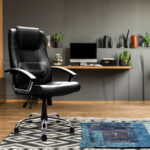This post contains affiliate links, and we will be compensated if you buy after clicking on our links.
Kneeling chairs have been gaining popularity in recent years as an alternative to traditional office chairs. They are designed to promote proper posture and reduce back pain by positioning the body in a way that reduces pressure on the lower back.
However, there are both pros and cons to using a kneeling chair, and it is important to understand how to use one properly in order to reap the benefits.
In this article, we will explore the pros and cons of kneeling chairs and provide tips on how to use them effectively.
Whether you are considering purchasing a kneeling chair for your office or are just curious about this alternative seating option, read on to learn more.

What is a Kneeling Chair?
Kneeling chairs are a type of ergonomic seating designed to promote better posture and alleviate pressure on the lower back.
They feature a unique design with a tilted seat and knee rests, which encourages the user to maintain an upright position while seated.
By positioning the hips at an open angle, kneeling chairs encourage a more natural spinal alignment, which can help to reduce discomfort and pain associated with poor posture or long periods of sitting.
The concept of kneeling chairs dates back to the 1970s when they were first developed by Norwegian designer Peter Opsvik.
They have since gained popularity as an alternative to traditional office chairs, particularly among people who suffer from lower back pain or want to improve their posture while working at a desk.

Benefits of Kneeling Chairs
Using a kneeling chair can offer numerous benefits to individuals who spend long periods sitting, especially while working at a desk. Some of these benefits include:
- Enhanced focus and productivity: By maintaining a more upright posture, you may find it easier to stay focused and engaged in your work. Better posture can lead to improved concentration and productivity.
- Relief from sciatica and other nerve-related issues: Kneeling chairs can help alleviate pressure on the sciatic nerve by distributing the body’s weight more evenly and reducing pressure on the lower back and buttocks. This can provide relief to those suffering from sciatica or other nerve-related discomforts.
- Improved hip flexibility and mobility: The open hip angle in a kneeling chair can help to stretch and open up the hip flexors, which can become tight and shortened from extended periods of sitting in a conventional chair. This increased flexibility can lead to improved mobility and reduced discomfort in the hip area.
- Balanced weight distribution: The design of a kneeling chair encourages weight distribution between the seat and the knee pads. This balanced weight distribution can help alleviate pressure points and discomfort, making it more comfortable to sit for extended periods.
- Encouragement of movement and micro-adjustments: Kneeling chairs often encourage subtle movements and adjustments, which can help to keep the muscles engaged and prevent stiffness from prolonged sitting.
- Engaged core muscles: The active seating position encourages the use of core muscles, which can help to improve overall muscle tone and support spinal health.
- Better breathing and circulation: An upright posture can improve diaphragmatic breathing and promote better blood circulation throughout the body.

Disadvantages of Kneeling Chair
While kneeling chairs offer several benefits, they also come with some disadvantages that are important to consider before choosing this seating option:
- Initial discomfort: For individuals who are new to kneeling chairs, the unfamiliar position can cause initial discomfort in the knees, shins, and leg muscles. This discomfort usually subsides as the body adapts to the new seating posture, but it may deter some people from using the chair.
- Limited adjustability: Many kneeling chairs have limited adjustments, which can make it difficult to find the optimal seating position for each person. This lack of customization can lead to discomfort and reduce the ergonomic benefits of the chair.
- Not suitable for everyone: Kneeling chairs may not be appropriate for individuals with specific knee or leg issues, as they can place additional pressure on these areas. Additionally, they might not be suitable for people with limited mobility or balance issues, as getting in and out of the chair can be more challenging compared to a traditional chair.
- Reduced support for the upper back and shoulders: Kneeling chairs typically do not provide support for the upper back and shoulders, which may lead to discomfort or strain in these areas for some users, especially during prolonged use.
- Learning curve: It can take some time to get used to sitting in a kneeling chair and maintaining the proper posture. Some users may find it challenging to adjust to the new seating position.

How To Use a Kneeling Chair
Using a kneeling chair involves a slightly different seating position compared to traditional chairs. To properly use a kneeling chair, follow these steps:
- Position the chair: Place the kneeling chair in front of your desk or workstation, ensuring it is stable and secure.
- Adjust the height: Some kneeling chairs have adjustable seat heights. If possible, adjust the seat height so that when you sit, your hips are slightly higher than your knees, and your feet are resting flat on the floor or on a footrest.
- Sit down: Carefully sit down on the chair, placing your buttocks on the seat pad. Your weight should be distributed between your buttocks and your knees. Ensure your thighs are at a 60-70 degree angle to your lower legs.
- Position your knees: Place your knees on the knee pads, keeping them at a comfortable distance apart. Your shins should rest against the shin supports, and there should be little to no pressure on your kneecaps. Ensure your knees are positioned comfortably, without feeling any strain or discomfort.
- Maintain an upright posture: The design of the kneeling chair encourages an upright posture with a natural curve in your lower back. Engage your core muscles and keep your chest open to maintain this posture. Avoid slouching or leaning forward excessively.
- Position your feet: Place your feet flat on the floor, shoulder-width apart, or on a footrest, if needed. Your feet should provide additional support and stability while seated.
- Adjust your workstation: Make sure your desk, monitor, keyboard, and mouse are at ergonomic heights and distances, so you don’t strain your neck, shoulders, or arms while working.
- Take breaks and change positions: As with any seating solution, it’s essential to take breaks and change positions throughout the day. Stand up, stretch, or walk around for a few minutes every hour to promote circulation and prevent muscle stiffness.
Remember, it may take some time for your body to adjust to sitting in a kneeling chair. If you experience discomfort initially, try using the chair for shorter periods and gradually increase the duration as your body adapts.

Kneeling Chairs versus Yoga Ball Chairs
Although there are some similarities between the Yoga chair and the kneeling chair, they also have distinct differences that may make one more appropriate than the other, depending on an individual’s specific needs and preferences. Let’s take a closer look at the Yoga Ball chair.
- Design: Yoga ball chairs consist of an inflated exercise ball, which may be placed on a frame with or without back support and casters. The user sits on the ball, engaging core muscles to maintain balance and stability.
- Stability: Yoga ball chairs are less stable than kneeling chairs, as the user must actively engage core muscles to maintain balance on the rolling surface.
- Focus on core engagement: Yoga ball chairs primarily encourage core muscle engagement and active sitting, which can improve muscle tone and overall stability.
- Increased movement: Yoga ball chairs allow for a greater range of movement and adjustments while seated, promoting active sitting and micro-movements throughout the day.
- Aesthetics: Yoga ball chairs may not blend as easily into a professional office environment due to their unconventional appearance and design.
➤ Learn more about the differences between bettewen Kneeling Chairs versus Yoga Ball Chairs

Kneelings Chair vs Stool Chair
While they share some similarities, they also have distinct differences that can make one more suitable than the other, depending on individual needs and preferences.
- Design: Stool chairs typically have a rounded or saddle-shaped seat without a backrest. Some models may be adjustable in height and tilt or have a rounded base that allows for rocking or wobbling motions.
- Posture focus: Stool chairs encourage an upright posture by engaging core muscles and promoting a more open hip angle.
- Increased movement: Stool chairs often allow for a greater range of movement and adjustments while seated, promoting active sitting and micro-movements throughout the day.
- No knee support: Stool chairs do not provide support for the knees, making them potentially more suitable for those with knee issues but offering less overall body support.
- Stability: Stool chairs with a flat base offer a stable seating surface, while those with a rounded base may require more active engagement to maintain balance.
➤ Learn more about the differences between Kneeling Chair Vs Stool Chairs

Conclusion
In conclusion, kneeling chairs offer a unique ergonomic seating solution that can provide numerous benefits, such as improved posture, reduced lower back pain, and increased core muscle engagement.
They are particularly helpful for individuals who spend long hours sitting at a desk or workstation.
However, it’s essential to consider the potential disadvantages, such as initial discomfort, limited adjustability, and suitability for specific tasks or individuals with certain health conditions.
Before choosing a kneeling chair, it’s crucial to weigh the pros and cons and consider individual preferences, comfort, and health needs.
Trying a kneeling chair before committing to a purchase can help determine if it’s the right fit. Additionally, consulting a healthcare professional or ergonomics expert can provide valuable guidance in making an informed decision.

FAQ
Are kneeling chairs suitable for everyone?
Kneeling chairs may not be suitable for everyone, especially individuals with pre-existing knee or leg issues, limited mobility, or balance concerns. Consult a healthcare professional before using a kneeling chair to ensure it’s appropriate for your needs.
How long should I sit in a kneeling chair each day?
It’s recommended to start with short periods of sitting in a kneeling chair and gradually increase the duration as your body adapts. Taking breaks and alternating between sitting and standing throughout the day is important for maintaining overall health.
Do kneeling chairs come in different sizes?
Yes, kneeling chairs come in various sizes, designs, and materials. Some models also offer adjustable features to better suit individual preferences and body types.
Can kneeling chairs help with lower back pain?
Kneeling chairs promote proper posture and reduce pressure on the lower back, which can help alleviate lower back pain for some individuals. However, it’s essential to consult a healthcare professional to address any underlying causes of pain.
Can I use a kneeling chair if I have knee problems?
If you have pre-existing knee issues, it’s essential to consult a healthcare professional before using a kneeling chair, as it may not be appropriate for your needs and could exacerbate your condition.
Is it difficult to transition from a traditional chair to a kneeling chair?
There can be a learning curve when transitioning to a kneeling chair, as the seating position is different from that of a traditional chair. It may take some time for your body to adjust, but most people can adapt to the new seating position with practice.
Related Articles









